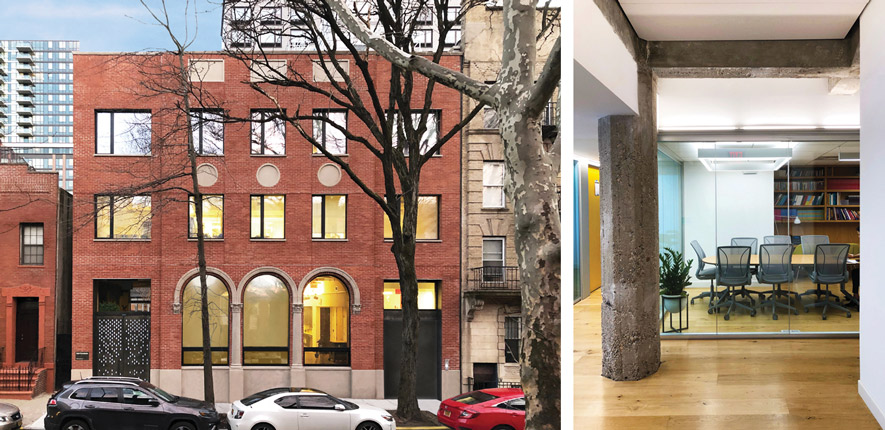Passive House
Learning Objectives:
- Explain the concepts behind the Passive House standard and its benefits.
- Discuss the application of Passive House to large-scale projects, including new buildings, retrofits, and mass-timber construction.
- Describe some of the challenges of designing and building to the Passive House standard.
- Discuss the compatibility of the Passive House standard with other low-operational-energy approaches.
Credits:
This course is approved as a Structured Course
This course can be self-reported to the AANB, as per their CE Guidelines
Approved for structured learning
Approved for Core Learning
This course can be self-reported to the NLAA
Course may qualify for Learning Hours with NWTAA
Course eligible for OAA Learning Hours
This course is approved as a core course
This course can be self-reported for Learning Units to the Architectural Institute of British Columbia
View course on architecturalrecord.com »
On a visit to the construction site for the renovation of the NoVo Foundation in Brooklyn on a hot day last summer, the interior of the building was pleasantly cool, even though the mechanical systems were not yet operating. The high levels of insulation added to the walls enclosing the 1920s concrete-framed structure had kept the heat out.

PHOTOGRAPHY: COURTESY RYALL PORTER SHERIDAN ARCHITECTS
Ryall Porter Sheridan renovated a former YMCA training center for the NoVo Foundation, a Brooklyn-based nonprofit. Bringing the building up to Passive House standards involved replacement of deteriorated facebrick and creating a new high-performance envelope (left). Much of the original cast-in-place structure has been left exposed on the interior (right).
On a return visit in February, the now-completed headquarters for the not-for-profit was agreeably warm inside, in spite of outdoor temperatures in the low 30s. No chill could be felt near the monumental triple-glazed street-facing windows. The warmth came not from a boiler, but from the heat generated by people, lights, and appliances. It was harvested from the ventilation exhaust and redistributed.
NoVo supports the well-being of girls and women worldwide, and its low-energy, 25,000-square-foot new home supports its future-focused mission. The headquarters, a former YMCA training center, has been renovated to consume very little energy in compliance with Passive House, the environmental standard that unites a highly insulated airtight envelope with minimized mechanical systems.
Born in central Europe, and developed for that relatively mild climate, the standard is now adapted to the much wider range of American regional conditions. Only a few years ago, Passive House projects were primarily single-family dwellings, but the strategy has moved into multifamily housing and retrofits, where the need and opportunities are great. The examples that follow—a 709-unit apartment complex in the Bronx, a 20,000-square-foot mixed-use development in Boston, and NoVo—demonstrate how Passive House can be applied to larger, more complex building types, and how it can be used in the Northeast United States, with its challenging combination of cold winters and warm, humid summers.
There are two Passive House–certifying organizations in the U.S. The Passive House Institute (PHI), based in New York, closely emulates its sister institute in Darmstadt, Germany. The Passive House Institute US (PHIUS), based in Chicago, meanwhile, has a somewhat separate standard, though both follow similar principles, and certification entails many of the same exacting construction practices.
To achieve Passive House’s airtight-envelope requirement, both standards stress the importance of continuous enhanced insulation. This means that every thermal bridge (any element that can conduct heat through the building envelope) is eliminated or wrapped by an insulating layer. A concrete slab can’t penetrate the envelope as an exterior balcony without a thermal break, for example. Even small voids around windows must be sealed. Most assemblies demand a waterproof barrier to keep water and air out, as in conventional construction, and another air barrier behind interior finishes. The practice eliminates air flow across the wall or roof section, yet permits vapor flow out of the assembly, preventing condensation and rust or mold from forming within the wall system.

IMAGES: COURTESY HANDEL ARCHITECTS
Sendero Verde, a three-building mixed-use complex rising in New York’s East Harlem, aspires to be a model of low-energy housing. Its tallest structure, a 37-story apartment building, is expected to be the largest multifamily Passive House project in the world.
Passive House buildings tend to have a higher proportion of wall to windows than conventional construction. Those windows, as well as glass doors, are generally specified with exceptionally low U-values (a measurement of heat transfer), achieved in cold climates with triple glazing and thermally robust frames and seals. Operable windows allow natural ventilation when conditions permit, further lowering the demand for mechanical tempering.
Building orientation that optimizes daylight for minimal use of electric lights, as well as limiting summer heat gain and harvesting solar warmth in winter, are essential to meet Passive House requirements.
Similarly, internal loads from equipment, appliances, lighting, and mechanical heating and cooling must be lowered. An energy-recovery ventilator (ERV) recycles the warm or cool exhaust air. Projects often use variable refrigerant flow (VRF) units or small, high-efficiency, air-source heat pumps called mini-splits. Both convey heating and cooling via refrigerants rather than using air or water.
These tactics, taken together, shrink the required capacity of heating and cooling systems by as much as 90 percent. Overall, the standard aggressively reduces energy use, by as much as 75 percent when compared to conventional building stock. If adopted widely, Passive House could become an important tool in reducing carbon emissions and combating global warming. And, because interior temperatures are relatively stable, Passive House structures are likely to remain habitable for days and even weeks in the event of a grid failure.
In addition to resilience and savings (especially important to affordable housing developers), Passive House designs are unusually comfortable and quiet, with their thick insulation and much-lowered noise from mechanicals. Air quality is excellent (only code-minimum 100 percent fresh air is moved through spaces), with drafts eliminated because of the high-performance windows and scrupulously detailed sealing of joints.















